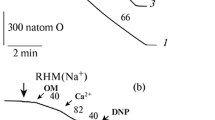Abstract
The contractile response to acidosis is the final product of a number of different changes in the excitation-contraction coupling pathway: (i) Cai increases and subsequently decreases during acidosis; (ii) the action potential becomes longer; (iii) the sensitivity of the contractile proteins to Ca2+ decreases. The increase of Cai and the lengthening of the action potential may help to maintain contractile function, although this advantage may be offset if spontaneous Ca2− release from the s.r. occurs, secondary to the increase of Cai. The recovery of force shown in figure 1 occurs at a time when the calcium transient is decreasing, and therefore represents an increasing sensitivity of the contractile proteins to Cai, probably due to a recovery of intracellular pH(6), although it is also possible that a disappearance of spontaneous Ca2+ releases from the s.r. may be contributing [2].
Similar content being viewed by others
References
Kurachi Y: The effects of intracellular protons on the electrical activity of single ventricular cells. Pflugers Archivs 394: 264–270, 1982
Orchard CH, Houser SR, Kort AA, Bahinski A, Capogrossi MC, Lakatta EG: Acidosis facilitates spontaneous sarcoplasmic reticulum Ca2+ release in rat myocardium. J Gen Physiol 90: 145–165, 1987
Orchard CH: The role of the sarcoplasmic reticulum in the response of ferret and rat heart muscle to acidosis. J Physiol 384: 431–449, 1987
Fabiato A, Fabiato, F: Effects of pH on the myofilaments and the sarcoplasmic reticulum of skinned cells from cardiac and skeletal muscles. J Physiol 276: 233–255, 1978
Hamilton DL, Orchard CH: The effect of acidosis on the relationship between Ca2− and force in isolated ferret cardiac muscle (Abstr.) J Physiol 391: 48P, 1987
Allen DG, Elliott AC, Orchard CH: The metabolic effects of acidosis in isolated ferret hearts (Abstr.) J Physiol 394: 40 p, 1987
Boyett MR, Kirby MS, Orchard CH: The effect of acidosis in single ventricular cells isolated from ferret heart (Abstr.) J Physiol 407: 114 p
Kentish JC: The effects of inorganic phosphate and creatine phosphate on force production in skinned muscles from rat ventricle. J Physiol 370: 585–604, 1986
Fabiato A: Use of aequorin for the appraisal of the hypothesis of the release of calcium from the sarcoplasmic reticulum induced by a change of pH in skinned cardiac cells. Cell Calcium 6: 95–108, 1985
Boyett MR, McCall E, Orchard CH: Effect of acidosis on mechanical restitution and the interval-force relation of ferret papillary muscles (Abstr.) J Physiol 406: 218 p
Blanchard EM, Solaro RJ: Inhibition of the activation and troponin calcium binding of dog cardiac myofibrils by acidic pH. Circ Res 55: 382–391, 1984
Orchard CH, Astles PA, Jewell BR: The effect of acidosis on the myofilaments of intact cardiac muscle (Abstr.) J Mol Cell Cardiol 20, Suppl. IV S48, 1988
Author information
Authors and Affiliations
Rights and permissions
About this article
Cite this article
Orchard, C. The effect of acidosis on excitation-contraction coupling in isolated ferret heart muscle. Mol Cell Biochem 89, 169–173 (1989). https://doi.org/10.1007/BF00220771
Accepted:
Issue Date:
DOI: https://doi.org/10.1007/BF00220771




